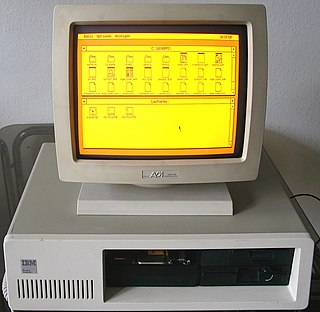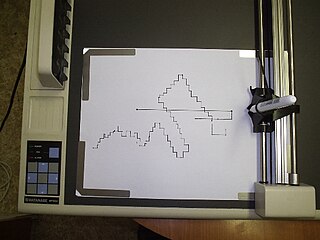DMPL, or Digital Microprocessor Plotter Language, is a vector graphics file format from Houston Instruments developed to control pen plotters and later used on cutting plotters.
This language is not compatible with HP-GL, see its EAGLE definition:
[HIDMP]Type=PenPlotterLong="Houston Instrument DMP plotter"Init=";:H A EC1 \n"Reset="P0 @\n"Width=16Height=11ResX=1000ResY=1000PenSelect="P%u\n"PenSpeed="V%1.0f\n"Move="U %d,%d\n"Draw="D %d,%d\n"PenCircleCxCyRxRy="CA %d,%d 360\n"
A plotter produces vector graphics drawings. Plotters draw lines on paper using a pen, or in some applications, use a knife to cut a material like vinyl or leather. In the latter case, they are sometimes known as a cutting plotter.
Roland Corporation is a Japanese manufacturer of electronic musical instruments, electronic equipment and software. It was founded by Ikutaro Kakehashi in Osaka on April 18, 1972. In 2005, Roland's headquarters relocated to Hamamatsu in Shizuoka Prefecture. It has factories in Malaysia, Taiwan, Japan, and the USA. As of March 31, 2010, it employed 2,699 people. In 2014, Roland was subject to a management buyout by Roland's CEO Junichi Miki, supported by Taiyo Pacific Partners.

2D computer graphics is the computer-based generation of digital images—mostly from two-dimensional models and by techniques specific to them. It may refer to the branch of computer science that comprises such techniques or to the models themselves.
OCaml is a general-purpose, multi-paradigm programming language which extends the Caml dialect of ML with object-oriented features. OCaml was created in 1996 by Xavier Leroy, Jérôme Vouillon, Damien Doligez, Didier Rémy, Ascánder Suárez, and others.
HP-GL, short for Hewlett-Packard Graphics Language and often written as HPGL, is a printer control language created by Hewlett-Packard (HP). HP-GL was the primary printer control language used by HP plotters. It was introduced with the plotter HP-8972 in 1977 and became a standard for almost all plotters. Hewlett-Packard's printers also usually support HP-GL/2 in addition to PCL.

GEM is an operating environment which was created by Digital Research (DRI) since 1984 for use with the DOS operating system on Intel 8088 and Motorola 68000 microprocessors.
Perl Data Language is a set of free software array programming extensions to the Perl programming language. PDL extends the data structures built into Perl, to include large multidimensional arrays, and adds functionality to manipulate those arrays as vector objects. It also provides tools for image processing, machine learning, computer modeling of physical systems, and graphical plotting and presentation. Simple operations are automatically vectorized across complete arrays, and higher-dimensional operations are supported.
Ligand field theory (LFT) describes the bonding, orbital arrangement, and other characteristics of coordination complexes. It represents an application of molecular orbital theory to transition metal complexes. A transition metal ion has nine valence atomic orbitals - consisting of five nd, one (n+1)s, and three (n+1)p orbitals. These orbitals are of appropriate energy to form bonding interaction with ligands. The LFT analysis is highly dependent on the geometry of the complex, but most explanations begin by describing octahedral complexes, where six ligands coordinate to the metal. Other complexes can be described by reference to crystal field theory.

OpenGL for Embedded Systems is a subset of the OpenGL computer graphics rendering application programming interface (API) for rendering 2D and 3D computer graphics such as those used by video games, typically hardware-accelerated using a graphics processing unit (GPU). It is designed for embedded systems like smartphones, tablet computers, video game consoles and PDAs. OpenGL ES is the "most widely deployed 3D graphics API in history".
COLLADA is an interchange file format for interactive 3D applications. It is managed by the nonprofit technology consortium, the Khronos Group, and has been adopted by ISO as a publicly available specification, ISO/PAS 17506.

OpenGL Shading Language (GLSL) is a high-level shading language with a syntax based on the C programming language. It was created by the OpenGL ARB to give developers more direct control of the graphics pipeline without having to use ARB assembly language or hardware-specific languages.
The Gliese Catalogue of Nearby Stars is a star catalogue listing stars located within 25 parsecs of the Sun.
Origin is a proprietary computer program for interactive scientific graphing and data analysis. It is produced by OriginLab Corporation, and runs on Microsoft Windows. It has inspired several platform-independent open-source clones and alternatives like LabPlot and SciDAVis.
The HP 7470 was a small low-cost desktop pen plotter introduced by Hewlett Packard's San Diego division in 1982. It was the first small-format plot that moved the paper, rather than the pens. It used a revolutionary "grit wheel" design which moved the paper held in place by a wheel with embedded grit and a pinch roller.
Calcomp Technology, Inc., often referred to as Calcomp or CalComp, was a company best known for its Calcomp plotters.
LTspice is a SPICE-based analog electronic circuit simulator computer software, produced by semiconductor manufacturer Analog Devices. It is the most widely distributed and used SPICE software in the industry. Though it is freeware, LTspice is not artificially restricted to limit its capabilities.

Graphtec Corporation, formerly Watanabe Instruments, is a company for computer input and output devices in Japan. It has subsidiaries in the USA, Europe and Australia. Graphtec was established in 1949; their first plotter was released in 1961.

The Apple 410 Color Plotter is a color plotter printer that was sold by Apple Computer, Inc. from 1983 to 1988. The colors came in either water- or oil-based inks.

glTF is a standard file format for three-dimensional scenes and models. A glTF file uses one of two possible file extensions, .gltf (JSON/ASCII) or .glb (binary). A .gltf file may be self-contained or may reference external binary and texture resources, while a .glb file is entirely self-contained. An open standard developed and maintained by the Khronos Group, it supports 3D model geometry, appearance, scene graph hierarchy, and animation. It is intended to be a streamlined, interoperable format for the delivery of 3D assets, while minimizing file size and runtime processing by apps. As such, its creators have described it as the "JPEG of 3D." The binary version of the format is called GLB, where all assets are stored in a single file.